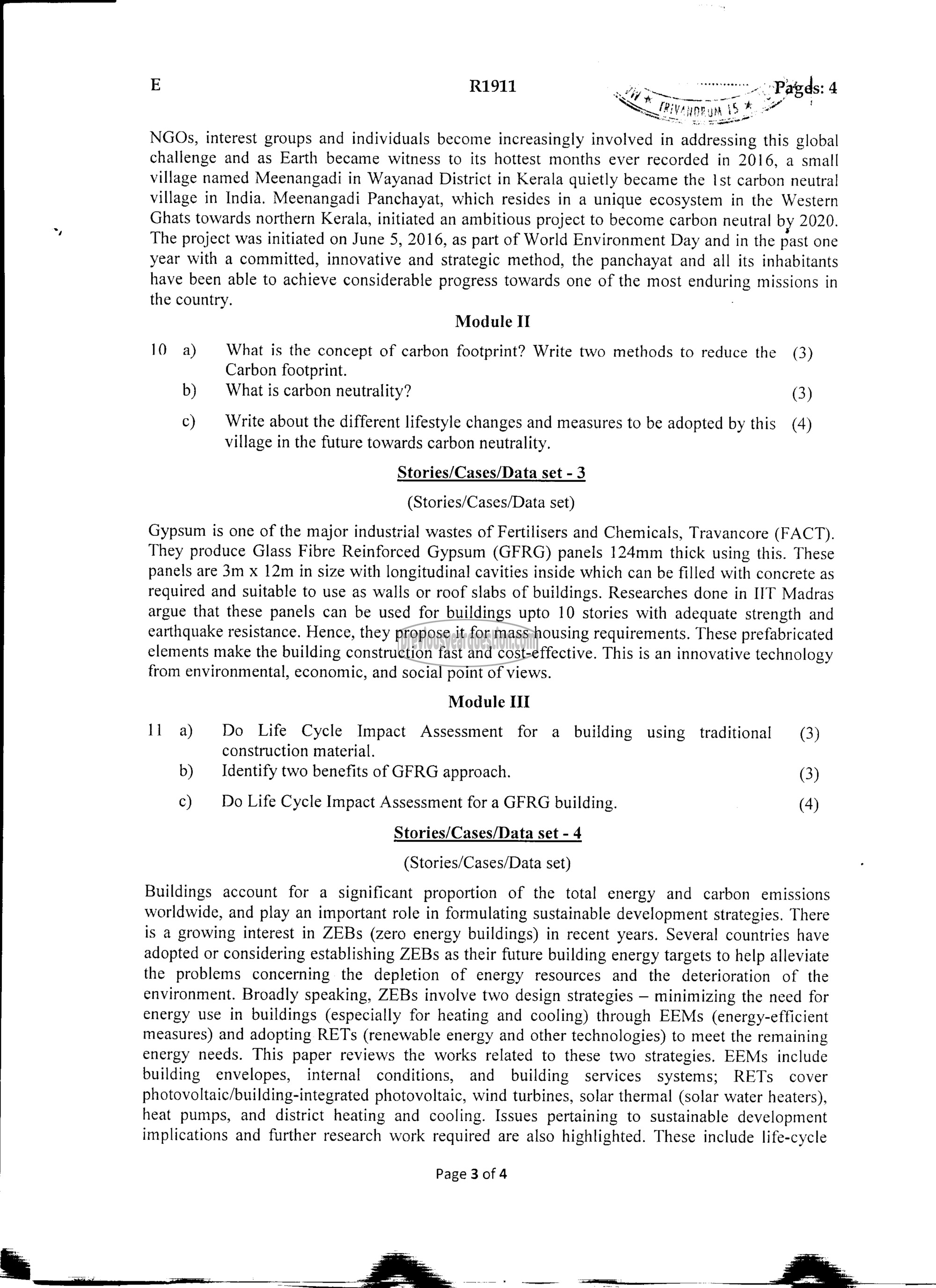APJ ABDUL KALAM TECHNOLOGICAL UNIVERSITY Previous Years Question Paper & Answer
Semester : S1 and S2
Subject : INTRODUCTION TO SUSTAINABLE ENGINEERING
Year : 2018
Term : DECEMBER
Branch : MECHANICAL ENGINEERING
Scheme : 2015 Full Time
Course Code : BE 103
Page:3
E R1911
NGOs, interest groups and individuals become increasingly involved in addressing this global
challenge and as Earth became witness to its hottest months ever recorded in 2016, a small
village named Meenangadi in Wayanad District in Kerala quietly became the Ist carbon neutral
village in India. Meenangadi Panchayat, which resides in a unique ecosystem in the Western
Ghats towards northern Kerala, initiated an ambitious project to become carbon neutral by 2020.
The project was initiated on June 5, 2016, as part of World Environment Day and in the past one
year with a committed, innovative and strategic method, the panchayat and all its inhabitants
have been able to achieve considerable progress towards one of the most enduring missions in
the country. ⋅
Module 11
10 a) What is the concept of carbon footprint? Write two methods to reduce the (3)
Carbon footprint.
0) What is carbon neutrality? (3)
९) Write about the different lifestyle changes and measures to be adopted by this (4)
village in the future towards carbon neutrality.
Stories/Cases/Data set - 3
(Stories/Cases/Data set)
Gypsum is one of the major industrial wastes of Fertilisers and Chemicals, Travancore (FACT).
They produce Glass Fibre Reinforced Gypsum (GFRG) panels 124mm thick using this. These
panels are 3m x 12m in size with longitudinal cavities inside which can be filled with concrete as
required and suitable to use as walls or roof slabs of buildings. Researches done in IIT Madras
argue that these panels can be used for buildings upto 10 stories with adequate strength and
earthquake resistance. Hence, they propose it for mass housing requirements. These prefabricated
elements make the building construction fast and cost-effective. This is an innovative technology
from environmental, economic, and social point of views.
Module III
11 8) Do Life Cycle Impact Assessment for a building using traditional (3)
construction material.
b) Identify two benefits of GFRG approach. (3)
c) Do Life Cycle Impact Assessment for ೩ GFRG building. (4)
Stories/Cases/Data set - 4
(Stories/Cases/Data set)
Buildings account for a significant proportion of the total energy and carbon emissions
worldwide, and play an important role in formulating sustainable development strategies. There
is a growing interest in ZEBs (zero energy buildings) in recent years. Several countries have
adopted or considering establishing ZEBs as their future building energy targets to help alleviate
the problems concerning the depletion of energy resources and the deterioration of the
environment. Broadly speaking, ZEBs involve two design strategies - minimizing the need for
energy use in buildings (especially for heating and cooling) through EEMs (energy-efficient
measures) and adopting RETs (renewable energy and other technologies) to meet the remaining
energy needs. This paper reviews the works related to these two strategies. EEMs include
building envelopes, internal conditions, and building services systems; RETs cover
photovoltaic/building-integrated photovoltaic, wind turbines, solar thermal (solar water heaters),
heat pumps, and district heating and cooling. Issues pertaining to sustainable development
implications and further research work required are also highlighted. These include life-cycle
Page 3 of 4
